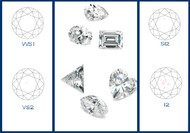Just like no two fingerprints are the same, no two diamonds are the same. They may have the same color, clarity, and size ranking but they are not identical. Each diamond is unique. It's been a while since we talked about the 4Cs. We touched on color and cut, but did not discuss clarity and carat. Let's take some time to delve into clarity and all that you need to know about it!
Clarity is defined as to how clean a diamond is from all natural inclusions. Inclusions or flaws are either formed internally or externally in a diamond. We like to call them natural beauty marks because they're not flaws, they're what make the diamond unique. Under extreme pressure & heat, these natural beauty marks are formed. A flawless diamond is extremely rare. In fact, even a diamond graded as flawless, could still have an extremely small mark undetectable to magnification. No diamond is absolutely perfect but they come close to perfection.
In 1953, the Gemological Institute of America (GIA) created the diamond grading system, which included how to grade diamonds in terms of clarity. Before this time, there was no consistent grading or terminology among jewelers to identify the clarity of a diamond. Now, every part of the world uses the GIA grading system as a basis when defining the clarity (or color & cut) of a diamond.
Below is the GIA diamond clarity grading system. Each ranking defines the clarity of a diamond and amount of inclusions on the diamond. To determine the clarity; the size, position, nature, color, & amount of inclusions are considered under 10x magnification. I1-I3 are generally identified as included diamonds. These type of diamonds usually will have larger inclusions, some cloudy, some dark carbon spots, and more. They can divert the beauty and brilliance of a diamond. Most diamonds graded as I1-I3 are less durable compared to other diamonds and are less brilliant. The likelihood of these type of diamonds chipping is slightly higher compared to the other clarity. Moving up along the chart, you'll see SI1-SI2, also known as slightly included. Inclusions in diamonds graded in this range generally are not seen with the naked eye, unless you are trained. Some laboratories will grade diamonds as SI3. There is no true SI3, it actually is an I1 or even I2. Inclusions will take a way from the brilliance of the diamond.
The other half of the chart are the cleaner diamonds. VS1-VS2, also known as very slightly included, are clean to the eye and difficult to see the inclusions under 10x magnification. VVS1-VVS2, also known as very very slight included, are extremely clean to the eye and extremely clean under magnification. And of course the last grading range is FL-IF, flawless to internally flawless. As we mentioned before, no diamond is absolutely perfect but if you are looking for a "flawless" diamond, then look for diamonds graded in this range. These diamonds are rare and of course more expensive. Most diamonds are graded between SI2-VS1.
One thing to keep in mind while shopping for diamonds, there are other laboratories (aside from GIA) that will use this type of grading system but tend to be more liberal in how they grade a diamond. Some laboratories will grade a diamond as SI2 but in GIA standards it would be graded as I1 or even I2. We always believe it's better to focus on GIA or AGS grading because it tends to be the best identifier of a diamond quality. But in the end, it really depends on the sparkle of the diamond and whether you love the look. Something to keep in mind while looking for your perfect diamond.
As always, there is so much information out about diamonds and sometimes a bit confusing, but hopefully we were able to simplify what clarity means and what to look for when buying diamonds. Not sure where to start, take a look at some of our loose diamond collection or you can stop in store and we'd be happy to answer any questions you may have! Happy diamond shopping!


